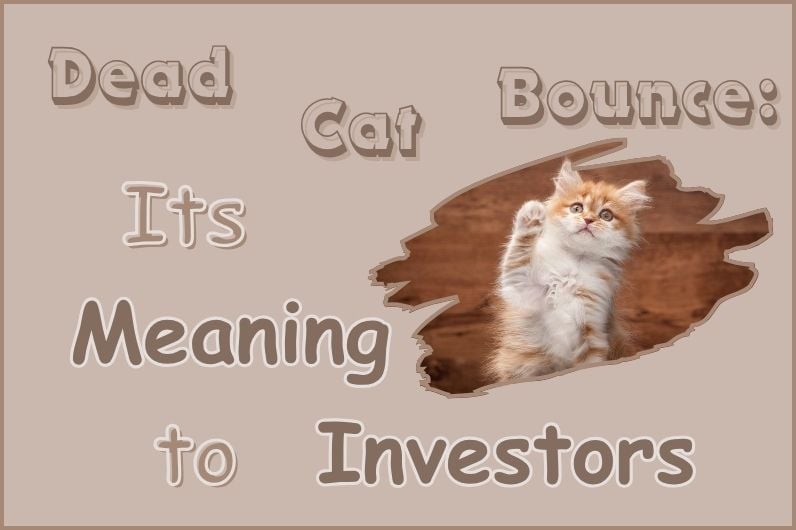A dead cat bounce means a short-term rally in a stock’s price after a more extended period of decline. It is a temporary rally lasting only a short time. The term is based on the idea that a dead cat will rebound if dropped from a sufficient height.
After the rally, the stock will fall further to new lows. Another synonymous term for dead cat bounce is a bear market rally. It is also called a sucker’s rally. Besides stocks, the term can apply to other securities, like bonds or the entire stock market.
Unfortunately, a dead cat bounce is apparent only in hindsight after the brief rally followed by the decline.
Affiliate
Free Dividend Kings Spreadsheet from Sure Dividend, complete with Buy/Hold/Sell recommendations, dividend histories, and much more.
Meaning of a Dead Cat Bounce to Investors
The term dead cat bounce is used in technical analysis and by traders to describe a stock’s price pattern. It is defined by a brief recovering stock price interrupting a longer downward trend. The uptick may last a few days, several weeks, or months; there is no pre-defined period.
The rally in a stock’s price is not sustainable and is short-lived. It is typically caused by temporary factors instead of an improvement in the business. Often a dead cat bounce is characterized by limited volume because retail and institutional investors have yet to be interested in the stock. Another feature is that the high set during the temporary rally is not as high as the previous peak indicating the downward trend is still present.
Importantly, this type of pricing action does not occur because of fundamentals. Instead, the stock price reversion is more speculative.
Why Does It Occur?
A dead cat bounce often occurs because traders believe a stock or other security has reached the bottom. Traders may have read or heard news causing them to buy the stock. The pricing pattern may also occur because of inexperienced investors or traders searching for the bottom. However, the fundamentals of the business have not materially changed, so the stock price continues to decline.
This event can also occur because of the closing or clearing of short positions. In this scenario, short sellers close their positions, buying stock, causing the stock’s price to rise.
Lastly, a dead cat bounce can occur because of the dominance of bearish sentiment. A brief respite in downward pressure is interrupted by a rally, but the declines continue due to bearish sentiment and continued selling.
When Does a Dead Cat Bounce Occur?
A dead cat bounce can occur at any time. But it often happens during a correction or bear market and a recession. Stock prices decline and are punctuated by brief increases, but the decline continues because the economic fundamentals are still negative.
Investors and traders probably cannot identify the pricing pattern characteristic of a dead cat bounce ahead of time. This point means a dead cat bounce can result in more losses if misidentified as an actual recovery. But, of course, the opposite is also true, and investors may miss the bottom. In either case, market timing can lead to significant losses.
Investors are better served by relying on fundamentals and buying and holding for total return.
Example
Many examples exist of a dead cat bounce. A recent example in the 2022 bear market is Microsoft (MSFT) stock.
The stock reached its all-time and 52-week high of $349.67 on November 22, 2021. Since then, it has declined continuously with periodic reversals. One possible example was the stock price reached a local low of $275.85 on March 8, 2022, followed by a recovery to $315.41 on March 29, 2022. Subsequently, Microsoft’s stock price declined further to $252.56 on May 20, 2022. The stock has seen several dead cat bounces in the bear market. Fast forward to November 6, 2022, and the price is $221.39, almost one-third lower than the all-time high.
Final Thoughts
A dead cat bounce is a market reality. Short rallies in the middle of a long downward trend often occur for stocks and the broader market. However, the pricing action is challenging to identify in advance and may be misleading. It can only be accurately determined after the fact. As a result, investors attempting to time the market may experience further losses.
Related Articles on Dividend Power
- John Bogle’s Estimated Future Annual Total Return Formula
- Advantages and Risks of Dividend Growth Investing
Here are my recommendations:
Affiliates
- Simply Investing Report & Analysis Platform or the Course can teach you how to invest in stocks. Try it free for 14 days.
- Free Dividend Kings Spreadsheet from Sure Dividend, complete with Buy/Hold/Sell recommendations, dividend histories, and much more. It is an excellent resource for DIY dividend growth investors and retirees.
- Stock Rover is the leading investment research platform with all the fundamental metrics, screens, and analysis tools you need. Try it free for 14 days.
- Portfolio Insight is the newest and most complete portfolio management tool with built-in stock screeners. Try it free for 14 days.
Receive a free e-book, “Become a Better Investor: 5 Fundamental Metrics to Know!” Join thousands of other readers !
*This post contains affiliate links meaning that I earn a commission for any purchases that you make at the Affiliates website through these links. This will not incur additional costs for you. Please read my disclosure for more information.
Prakash Kolli is the founder of the Dividend Power site. He is a self-taught investor, analyst, and writer on dividend growth stocks and financial independence. His writings can be found on Seeking Alpha, InvestorPlace, Business Insider, Nasdaq, TalkMarkets, ValueWalk, The Money Show, Forbes, Yahoo Finance, and leading financial sites. In addition, he is part of the Portfolio Insight and Sure Dividend teams. He was recently in the top 1.0% and 100 (73 out of over 13,450) financial bloggers, as tracked by TipRanks (an independent analyst tracking site) for his articles on Seeking Alpha.
